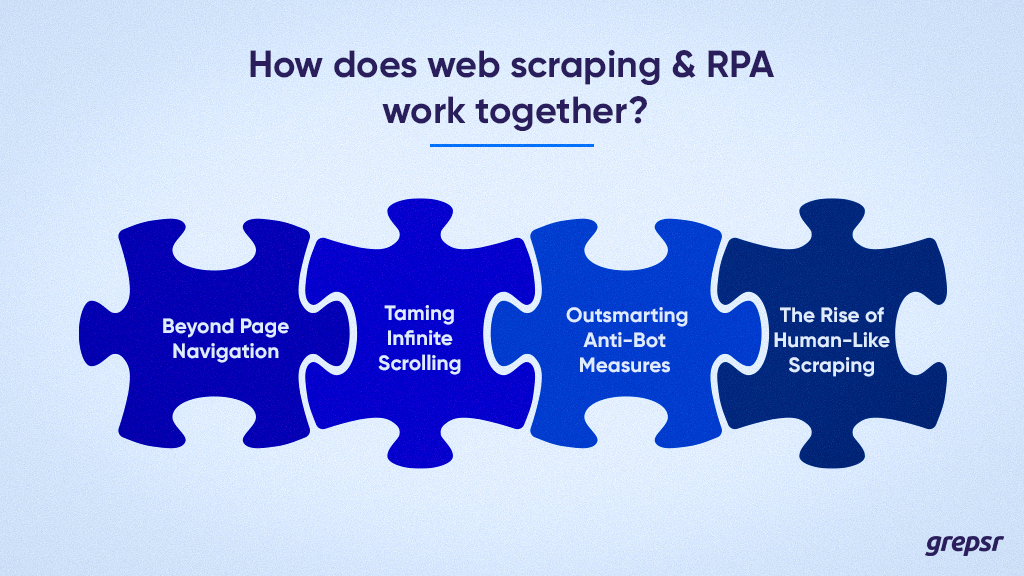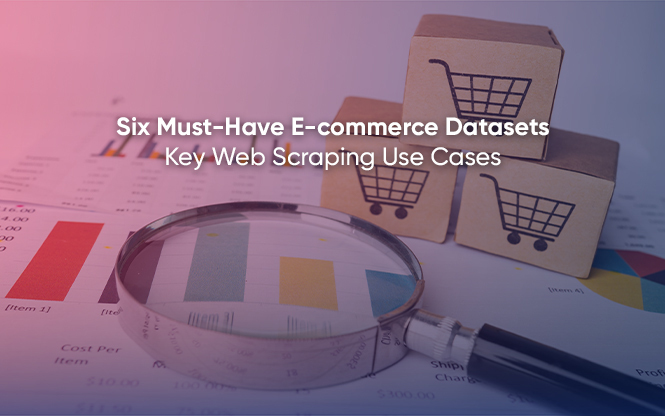
Search here
Can't find what you are looking for?
Feel free to get in touch with us for more information about our products and services.

Web scraping automatically extracts structured data like prices, product details, or social media metrics from websites.
Robotic Process Automation (RPA) focuses on automating routine and repetitive tasks like data entry, report generation, or file management.
When seamlessly integrated through tools like webhooks or API calls, these technologies can significantly boost an organization’s operational efficiency by streamlining data-driven workflows and freeing up human resources for higher-value tasks.
What is RPA?
Progress is great, but it is also messy. We frequently hear about groundbreaking ideas, but the iterative journey, door-to-door interactions, and data collection struggles are seldom highlighted.
Developing a great product or introducing a new feature often involves tedious, repetitive tasks—work that is essential but not necessarily glamorous.
Robotic Process Automation (RPA) is a technology designed to streamline and automate these trigger-based repetitive tasks, allowing more space for creative thinking and innovation.
Examples of Mundane Tasks Automated with RPA:
Data Entry:
Transferring data between systems, like entering information from emails, forms, or spreadsheets into a database or CRM system.
Inventory Management:
Automatic updating of inventory levels, tracking stock movements, and generating purchase orders based on predefined industry thresholds.
File Management:
Copying files from one location to another, organizing data, and managing file structures efficiently.

When to Automate Data Extraction with RPA: Finding the Perfect Fit

Automating data extraction can be incredibly efficient, but not every project is a match for RPA. Here are some key characteristics that signal it’s time to call in the robotic assistant:
Rule-Based Process: Can the data extraction process be broken down into predictable steps with consistent rules? Think filling forms, navigating specific pages, and extracting data from predetermined locations.
Defined Triggers: Does the process have a clear starting point, like a new file upload, a scheduled time slot, or a specific user action? Knowing when to begin ensures your RPA bot springs into action at the right moment.
Structured Data: Does the data follow a fixed format, both in input and output? Consistent spreadsheets, API calls, and database insertions are ideal partners for RPA.
Repetitive Volume: Is the data extraction task frequent and repetitive, involving a significant amount of data? The more routine and voluminous the work, the sweeter the automation rewards.
Remember, it’s always wise to test manual procedures first.
Manual testing acts as the priming step for the RPA engine. A smooth running engine requires proper preparation, and just so, proper testing fuels seamless data extraction.
How does Web Scraping and RPA work together?
While the “get data” mantra underpins any web scraping project, web scraping rarely involves merely identifying website URLs, writing a rudimentary crawler, and waiting for neatly organized CSV or JSON files. This simplified scenario masks the intricate web of challenges modern scraping demands.

Let’s delve deeper and explore the true complexities we encounter in real-world, web scraping scenarios:
Beyond Page Navigation: Simple crawlers navigating static pages are relics of the past. Today’s websites often require user interaction, like clicking drop-down menus or navigating “load more” buttons.
Handling dynamic elements necessitates advanced tools and techniques beyond basic crawlers.
Taming Infinite Scrolling: Websites with infinite scroll present a unique challenge. Scraping tools must dynamically recognize and handle new data chunks as they’re loaded, preventing incomplete or inaccurate data capture.
Outsmarting Anti-Bot Measures: As websites become more sophisticated, employing bot detection mechanisms, the need for intelligent scraping strategies rises.
Mimicking human behavior and respecting robots.txt protocols become crucial to avoid detection and ensure successful data extraction.
The Rise of Human-Like Scraping: The evolution of anti-bot measures demands scraping techniques that seamlessly mimic human interaction. This often involves advanced tools employing techniques like JavaScript rendering and browser automation frameworks.
Where RPA enters the Game
Managing these complexities can be daunting, especially for occasional data extractors.
This is where Robotic Process Automation (RPA) can be your game-changer. RPA bots can automate complex workflows, mimicking user interactions and handling dynamic elements with ease.
They can click buttons, scroll through infinite pages, and navigate intricate website structures, freeing you from the technical burden.
The Need for Web Scraping and RPA Expertise
With websites actively working to deter bots, programming crawlers that behave authentically and evade detection requires a high degree of expertise.
This is where managed data extraction services like Grepsr come into play. We have skilled teams and advanced tools equipped to tackle the most complex scraping challenges, ensuring reliable and efficient data acquisition.
By acknowledging the intricacies of modern web scraping and embracing advanced tools like RPA, you can unlock the true potential of this powerful data extraction technique.
A Web Scraping & RPA Use Case: Real Estate Market Analysis
Background: A real estate investment company, ABC Realty, wants to automate the process of gathering information on property listings from Zillow to analyze market trends and identify potential investment opportunities.
Objective: Automate the extraction of real estate listing details, including property prices, locations, and features, from Zillow for market analysis.
RPA Bot Navigation: Develop an RPA bot that navigates to the Zillow website. The bot enters specific search criteria, such as location, property type, and price range, to narrow down the search results.
Web Scraping: The RPA bot identifies and clicks on the first property listing link on the search results page.

Inside the property listing page, the bot scrapes relevant data, such as property price, location, size, number of bedrooms, bathrooms, and any additional features.
Data Processing and Storage: Process the scraped data to extract and organize the relevant information.
Store the real estate listing data you collect in a structured format (e.g., CSV, Excel, or database) for further analysis or integration with ABC Realty’s internal systems.
Buried in Data? Web Scraping and RPA can dig you out
Web overflowing with useless info? Can’t find the insights you need? Manual data gathering drowning you? We get it. Competition’s fast, you need an edge.
Grepsr is here for you with web Scraping & RPA for shoveling, digging, and unearthing valuable data.
Scraping grabs exactly what you need, while RPA automates the grunt work.
Imagine:
- Market trends and competitor intel at your fingertips.
- No more endless data entry or tedious reports.
- More time for strategy and decisions that drive growth.
We offer discreet, efficient solutions tailored to you.















